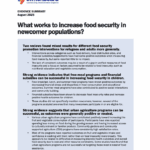Risk and prevalence of food insecurity and use of food security resources are important but incompletely understood factors in immigrant health. Key informant interviews and a survey (N = 809) of housing units were conducted in a San Diego, California neighborhood with a high proportion of immigrant and low income families. The difference in food insecurity between immigrant and nonimmigrant households was non-significant (20.1 vs. 15.7 %, p = n.s.), though immigrant families were more likely to use food security resources such as SNAP (32.7 vs. 22.9 %, p .01) and food pantries (28.2 vs. 19.7 %, p .001). Among immigrants, neither national origin nor years in the United States predicted food insecurity or use of most food security resources. In immigrant families, food insecurity often remains a challenge long after immigration, suggesting a potentially increasing need for food security resources as immigration into the United States continues.
The management of volunteers – What can human resources do? A review and research agenda
There is an increasing interest from scholars and practitioners in understanding how non-profit organizations can design and implement human resources (HR) practices to enhance desirable volunteer attitudes and behaviors. This paper presents a comprehensive overview of existing studies on the relationship between HR practices and volunteering outcomes. We use the ability-motivation-opportunity model as a guiding…

